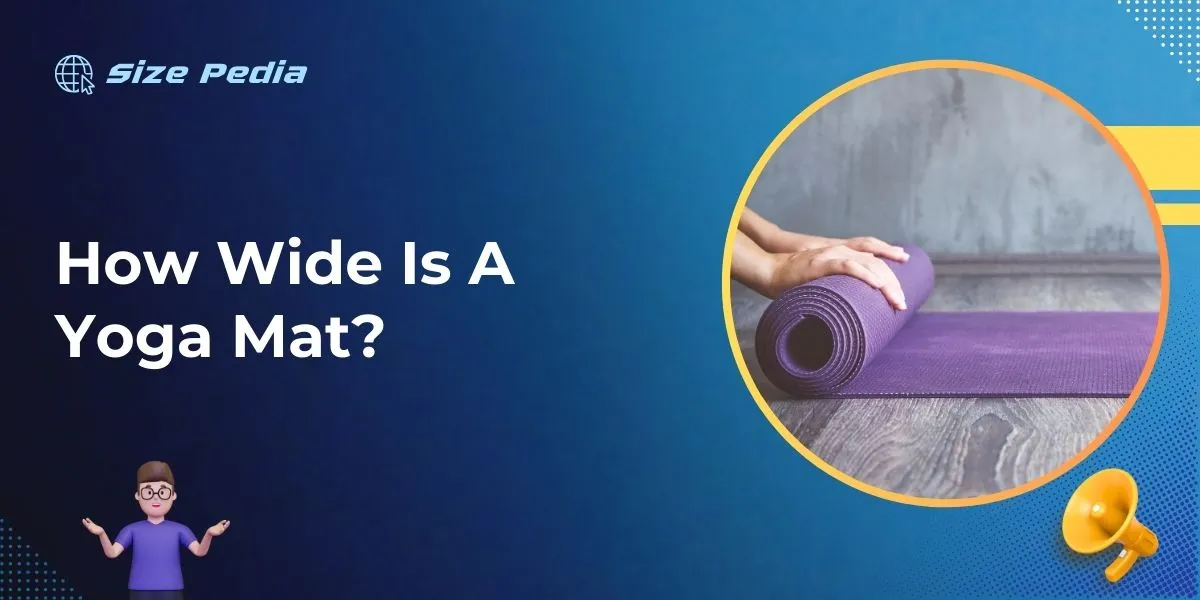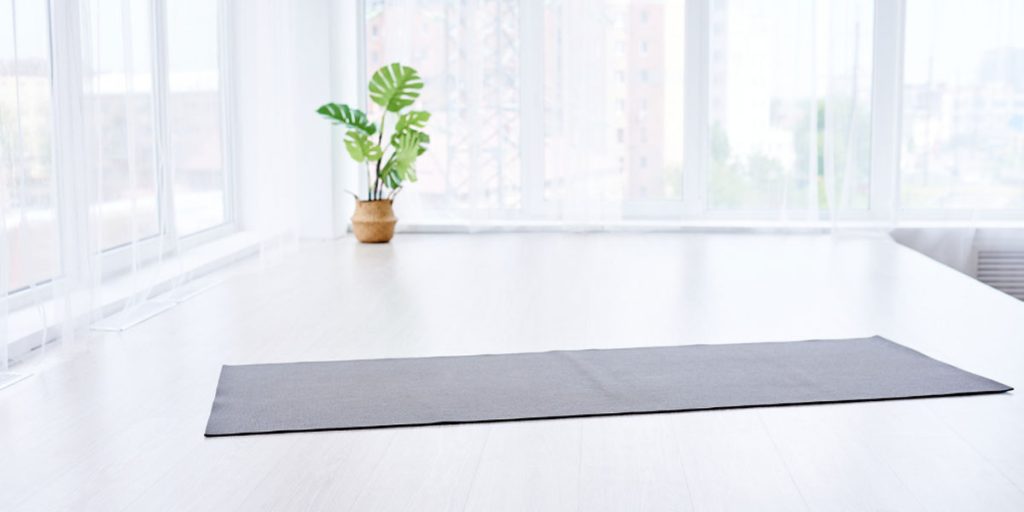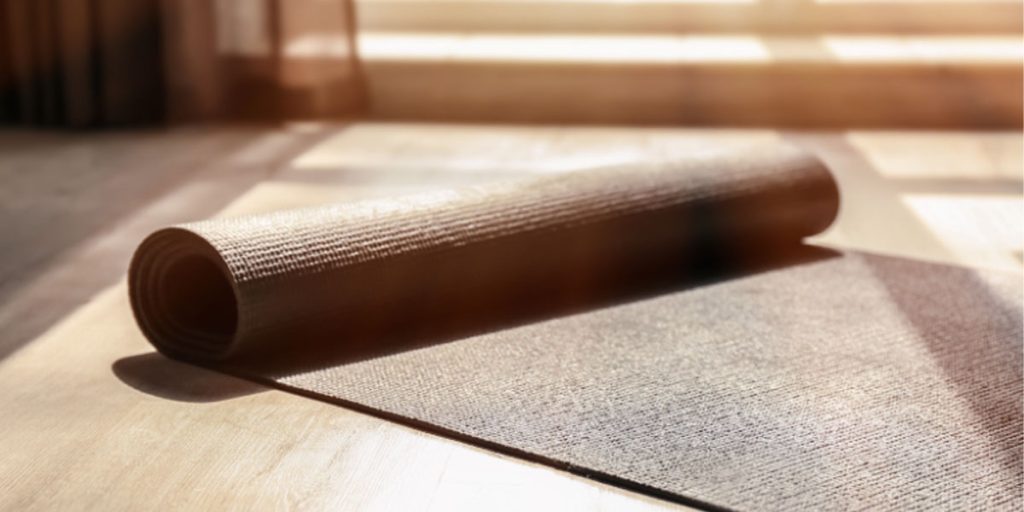A standard yoga mat is typically around 24 inches wide. The length often varies, ranging from 68 to 74 inches.
Yoga enthusiasts understand the importance of selecting the right mat, not only for comfort but also for maintaining proper alignment and stability during their practice.
With a multitude of options on the market, the dimensions of a yoga mat can impact your yoga experience significantly.
A mat’s width ensures you have enough space to perform various poses without feeling constricted.
Whether you’re practicing at home or in a studio, choosing a mat that aligns with your body type and personal preference is crucial for a fulfilling yoga session.
The width, texture, and material of your yoga mat can either enhance or hinder your practice, making it essential to consider these factors carefully before making a purchase.

Yoga Mat Width Essentials
Understanding the width of a yoga mat is crucial for comfort and stability during practice.
From beginners to advanced yogis, knowing the essentials about yoga mat width can make all the difference. Let’s roll out the mat on this topic and dive into the specifics.
Typical Dimensions Of Yoga Mats
Standard yoga mats often come in a particular size. But exactly how wide is a yoga mat? This is a question many practitioners ask to optimize their practice.
| Mat Type | Width | Length |
|---|---|---|
| Standard | 24 inches | 68 inches |
| Extra Wide | Up to 36 inches | 72 inches or longer |
Most mats are around 24 inches wide. Some brands offer extra-wide options, which can be up to 36 inches wide.
Factors Influencing Yoga Mat Width
Choosing the perfect mat width is influenced by different aspects. Here’s what can affect your decision:
- Yoga Style: More active styles need more space.
- Body Size: Taller or broader individuals may prefer wider mats.
- Comfort: Some prefer extra space for lying down poses.
- Portability: Wider mats can be heavier and harder to carry.
- Room Size: The space you practice in can dictate mat size.
Your preferred yoga style often dictates mat width. Body size influences comfort as well. Individuals with broader shoulders or height may opt for a wider mat.
Your comfort on the mat should be a priority. Wider mats provide extra space, especially beneficial in poses where you lie down.
Consider portability if you travel with your mat. Larger mats are also heavier. Finally, think about the room size where you will practice. Ensure your mat fits comfortably in the space.
Importance Of Yoga Mat Sizing

Choosing the right size for a yoga mat matters a lot. A yoga mat that fits provides comfort and safety during practice. It supports all your movements.
Your height and the types of yoga you do help decide the best size. Let’s explore why the width and length of your yoga mat are key to a great yoga experience.
Comfort And Freedom Of Movement
Finding a yoga mat that feels right is crucial. The mat should allow you to move freely. It should be wide enough to perform poses without stepping off the edge.
This can disrupt your flow and focus. A too small mat might cause discomfort. A wider mat gives the space you need.
Below are points showing why a wider mat adds to your comfort:
- Space for flowing poses: Wide mats offer the extra area necessary for sequences like Sun Salutations.
- Cushioned support: Provides ample padding for knees, elbows, and wrists.
- No restrictions: Lets you stretch out fully in poses like Savasana without feeling constrained.
Alignment And Balance Considerations
A well-sized yoga mat helps maintain alignment. Good alignment is vital to prevent injuries. It keeps your body in the right position.
Balance can be tricky in yoga. A mat of the right width offers stability. You’ll feel secure during standing and balancing poses.
Here are points highlighting alignment and balance benefits:
| Feature | Benefit |
|---|---|
| Mat Width | Ensures hands and feet remain on the mat for balance poses. |
| Consistent Surface | Promotes even weight distribution for better posture and alignment. |
| Defined Space | Helps visual alignment, making it easier to adjust your position. |
Types Of Yoga And Mat Width

Choosing the right yoga mat width can enhance your practice. Each yoga style has different needs. Some need extra space while others do not.
Mat Sizes For Various Yoga Styles
The standard yoga mat is about 24 inches wide. But, some styles may benefit from wider options.
- Vinyasa Yoga: The standard size works well. Quick movements don’t need more space.
- Hatha Yoga: A standard mat is also good. Poses are not too wide.
- Yin Yoga: Regular width is okay. Slow movements do not need extra width.
- Ashtanga Yoga: A standard mat is typically suitable. Flow is constant but contained.
- Iyengar Yoga: Go for a wider mat. Precision and props use more space.
- Anusara Yoga: A wider mat may help. Poses often use more room.
- Restorative Yoga: Wider mats add comfort. Supports relaxation.
| Yoga Style | Recommended Mat Width |
|---|---|
| Vinyasa, Hatha, Yin, Ashtanga | 24 inches |
| Iyengar, Anusara, Restorative | 28-30 inches or more |
Customizing Your Mat For Your Practice
Custom mats help your yoga practice. You can choose the best size for your body and style.
- Start by measuring your wingspan. This is a good width for your mat.
- Consider your height. Taller individuals may want a wider and longer mat.
- Think about your practice space. Ensure your mat fits well in the area.
- Choose a mat that feels comfortable. It should support all your movements.
Create your perfect yoga space. Personalize your mat to make your yoga journey unique and comfy.
Material Impact On Yoga Mat Size
Yoga mats come in various sizes, and their materials play a key role. Some stretch, others don’t. Strong, stretchy mats may give a bit underfoot.
Firmer, non-stretchy materials hold their shape. Here’s how different materials affect yoga mat size:
Stretch And Compression Of Different Materials
Different yoga mat materials react uniquely to pressure and stretching.
- PVC mats – Offer little stretch, maintaining shape and size.
- Rubber mats – Provide a slight give, potentially stretching over time.
- TPE mats – Strike a balance, with moderate stretch and rebound.
- Cotton mats – Highly pliable, can compress and stretch, altering the mat’s size.
Durability And Wear Over Time
Yoga mat size can change with use and time. Some materials wear thin, others lose firmness. Here’s how they stack up:
| Material | Stretch Over Time | Wear Pattern |
|---|---|---|
| PVC | Maintains form | May crack or peel |
| Rubber | Can expand | Stays robust, but can erode |
| TPE | Little stretch | Wears evenly |
| Cotton | Most pliable | Can thin out, but easily washed |
Finding Your Ideal Mat Size
Selecting the perfect yoga mat size enriches your practice. A mat that fits your body and space ensures comfort and safety.
It helps avoid slips and supports your poses. Let’s explore how to choose the right one.
Assessing Your Personal Needs
Consider your height and the types of yoga you enjoy. Tall individuals may need longer mats. High-intensity practices might require wider options for extra space.
- Yoga style: Vigorous practices need more room.
- Body size: Taller people should look for longer mats.
- Comfort: Thickness can add comfort for joints.
Tips For Testing Mat Sizes
Trying mats before buying is key. Visit stores and stretch on various mats. Feel the surface. Do your hands and feet fit when you lay flat? Can you move freely?
- Visit a store: Compare mats hands-on.
- Lie down: Check if your body fits within the mat’s borders.
- Simulate poses: Ensure your practice has room to flow.
| Type | Size (inches) | Best For |
|---|---|---|
| Standard | 68 x 24 | Most practitioners |
| Extra-long | 72 – 84 x 24 | Taller individuals |
| Wide | 68 – 71 x 26 – 28 | Dynamic practices |
Care And Maintenance Of Wide Yoga Mats
Wide yoga mats offer ample space for practice but need extra care. Regular cleaning and proper storage extend their life. Learn to maintain your wide mat with these easy tips.
Cleaning Techniques For Wider Mats
Keeping a wide yoga mat clean ensures durability and hygiene. Follow these simple steps:
- Mix gentle soap with water in a spray bottle.
- Spray the solution lightly across the mat.
- Use a soft cloth to wipe the mat clean.
- Rinse with a damp cloth to remove soap residue.
- Air dry the mat completely before rolling it up.
For a deeper clean, here’s a quick recipe:
| Ingredient | Amount |
|---|---|
| White Vinegar | 1 Cup |
| Water | 3 Cups |
| Essential Oil | 1 Tsp |
Mix, apply, scrub with a brush, and air dry. Avoid harsh chemicals that may damage the mat.
Storage Solutions For Large Mats
Storing your large yoga mat correctly is crucial. Rolled-up mats save space and prevent creases. Here’s a space-saving tip:
- Roll up the mat loosely to avoid stretching.
- Use a mat strap or carrier for easy transport.
- Store in a cool, dry place away from direct sunlight.
Have limited space? Hang your mat on a wall-mounted rack. Ensure air can circulate to prevent mold.
FAQs About the Width of a Yoga Mat
What Is The Width Of A Yoga Mat?
The standard width of a yoga mat is typically around 24 inches (61 centimeters). Some mats may offer variations in width for personal preference.
How Far Apart Should Yoga Mats Be?
Yoga mats should generally be spaced about 2 feet apart. This allows enough room for individual movement without interference. Maintain personal space for comfort and safety during practice.
Is A 1 4 Inch Yoga Mat Too Thick?
A 1/4 inch yoga mat is not too thick; it offers a comfortable cushion for joints while providing stable support for balance poses.
Do I Need 4mm Or 6mm Yoga Mat?
Choose a 4mm yoga mat for standard support and portability. Opt for a 6mm mat if you require extra cushioning for joints during your yoga practice.
Conclusion
Selecting the right yoga mat width is essential for comfort and performance. Standard mats typically measure 24 inches, but options vary to suit all body types.
Remember, the perfect mat balances personal space with studio practicality. Discover your fit and enhance your yoga journey today.
Resources:
https://www.tsa.gov/travel/security-screening/whatcanibring/items/yoga-mat
https://www.nccih.nih.gov/health/yoga-what-you-need-to-know
